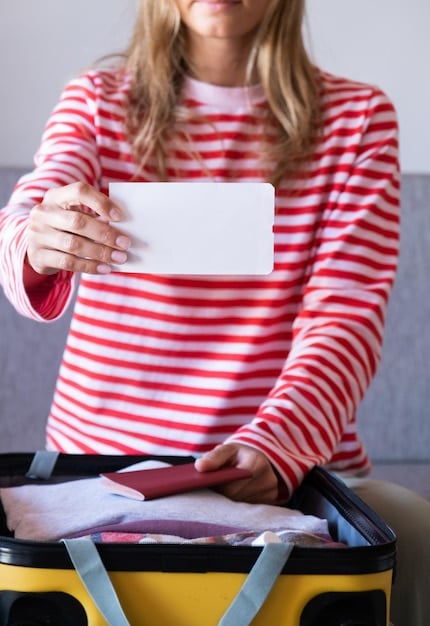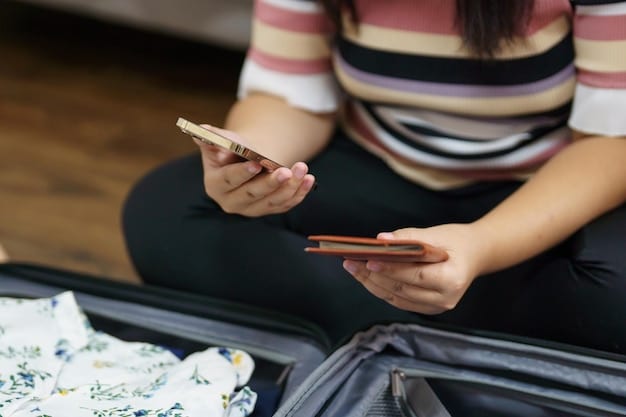Lost Luggage Survival Guide: What to Do When Your Bags Don’t Arrive

Lost luggage can disrupt any trip, but knowing how to respond can alleviate stress and ensure rightful compensation, from immediate reporting to filing claims with airlines and utilizing travel insurance.
Losing your luggage can turn a dream vacation into a stressful ordeal. This lost luggage survival guide provides essential steps to take if your bags don’t arrive, and explains how to navigate the compensation process.
Lost Luggage: Immediate Actions to Take
Discovering your luggage is missing at the baggage claim can be alarming. Here’s a sequence of steps to take immediately to start the recovery process and protect your rights.
Report the Missing Luggage Immediately
The first and most crucial step is to report the missing luggage to the airline. Do this before leaving the airport. Every minute counts in initiating the search process.
- Locate the airline’s baggage service desk in the baggage claim area.
- Provide your baggage claim tags, which you received when you checked your bags.
- Fill out a Property Irregularity Report (PIR). Get a copy of this report for your records.
Document Everything
Documentation is your best friend in these situations. The more details you provide, the easier it will be for the airline to locate your luggage and process any claims.
- Keep copies of your flight tickets and baggage claim tags.
- Note the date, time, and flight number of your arrival.
- Detail the contents of your luggage as accurately as possible in the PIR.
Reporting your luggage promptly and accurately sets the stage for a more efficient recovery process. Being thorough in your documentation can significantly aid in the airline’s search.
Filing a Claim with the Airline: Know Your Rights
Once you’ve reported the loss, the next step is to file a claim. Understanding your rights and the airline’s responsibilities is key to getting fair compensation.
Understanding Airline Liability
Airlines have specific liabilities when it comes to lost, delayed, or damaged luggage. Under the Montreal Convention, airlines are liable for up to approximately $1,780 USD per passenger for international flights. For domestic flights within the U.S., the liability limit is typically around $3,800 USD.
Steps to File a Claim
Filing a claim involves specific procedures and deadlines. Adhering to these can significantly impact the outcome of your claim.

- Obtain a claim form from the airline.
- Fill out the form accurately and completely.
- Attach all necessary documentation, including the PIR, baggage claim tags, and receipts for any expenses incurred due to the delay.
What Expenses Can You Claim?
You can typically claim for essential items you had to purchase due to the delay, such as toiletries, clothing, and medication. Keep receipts for all purchases, as these will be required to support your claim.
- Toiletries and personal hygiene items
- Clothing appropriate for the duration of the delay
- Medication or essential medical supplies
Knowing what you can claim for and understanding the airline’s liability can help you maximize your compensation. Keep all documentation organized and be persistent in your follow-ups.
Leveraging Travel Insurance for Lost Luggage
Travel insurance is designed to cover unexpected events during your trip, and lost luggage is often included. Here’s how to leverage your travel insurance policy effectively.
Check Your Policy Coverage
Before your trip, review your travel insurance policy to understand what it covers regarding lost, delayed, or damaged luggage. Pay attention to the limits and exclusions.
Filing a Claim with Your Insurance Company
Once you’ve filed a claim with the airline, you can proceed with filing a claim with your travel insurance company. This can provide additional compensation beyond what the airline offers.
- Obtain a claim form from your insurance provider.
- Provide all relevant documentation, including the PIR, airline claim information, and receipts.
- Follow up regularly with your insurance company to check the status of your claim.
Travel insurance can act as a safety net, providing additional coverage and peace of mind. Understanding your policy and filing claims promptly can significantly ease the financial burden of lost luggage.
Tracking Your Lost Luggage and Staying Persistent
After filing your initial reports and claims, staying proactive in tracking your luggage is crucial. Persistence can make a significant difference in the outcome.
Utilizing Online Tracking Tools
Most airlines provide online tracking tools that allow you to monitor the status of your lost luggage. Use these tools regularly to stay updated.
- Use the reference number provided on your PIR to check the status online.
- Check the airline’s website or app for updates.
- Contact the airline’s baggage service center for more detailed information.
Following Up with the Airline
Regularly follow up with the airline to ensure they are actively searching for your luggage. Persistence can often expedite the process.
- Call the airline’s customer service regularly, keeping a record of each call.
- Send emails to the baggage service center requesting updates.
- Escalate the issue to a supervisor if necessary.

Tracking your luggage and staying persistent shows the airline that you are serious about recovering your belongings. Regular communication can increase the chances of a positive resolution.
Preventive Measures to Minimize Luggage Loss
While you can’t completely eliminate the risk of lost luggage, you can take steps to minimize it. These preventive measures can increase the chances of your bags arriving safely.
Use Luggage Tags and Identifiers
Properly identifying your luggage with durable tags and identifiers is essential. Ensure your tags include your name, address, email address, and phone number.
Take Photos of Your Luggage and Contents
Before you travel, take photos of your luggage, both inside and out. This can help with identification and provide documentation for insurance claims.
- Photograph the exterior of your bag, noting its color, size, and any distinguishing features.
- Photograph the contents, especially valuable or unique items.
Use Direct Flights Whenever Possible
Connecting flights increase the risk of luggage being mishandled. Opt for direct flights whenever possible to reduce the chances of loss.
Taking these preventive measures can significantly reduce the likelihood of luggage loss. Being proactive in protecting your belongings can provide peace of mind during your travels.
Lost Luggage Compensation: What to Expect
Navigating the compensation process for lost luggage can be complex. Here’s what to expect and how to ensure you receive fair compensation.
Document Your Losses Thoroughly
Accurate documentation is crucial for a successful claim. Keep detailed records of all items lost and their values, along with any expenses incurred due to the delay.
- Create a detailed inventory of the lost items.
- Gather receipts or other proof of purchase for each item.
- Document any consequential damages resulting from the loss.
Negotiating with the Airline
Be prepared to negotiate with the airline to reach a fair settlement. Understand your rights and be persistent in advocating for your claim.
- Know the airline’s liability limits and your rights under the Montreal Convention or domestic regulations.
- Provide all necessary documentation to support your claim.
- Be polite but firm in your negotiations.
Understanding the lost luggage compensation process and documenting your losses meticulously can increase your chances of receiving fair compensation. Persistence and knowledge of your rights are key to a successful claim resolution.
| Key Point | Brief Description |
|---|---|
| ✈️ Report Immediately | Report lost luggage to the airline before leaving the airport. |
| 🧾 Document Well | Keep copies of all tickets, tags, and receipts. |
| 🛡️ Check Insurance | Review your travel insurance policy for lost luggage coverage. |
| 🧐 Stay Persistent | Regularly follow up with the airline and insurance company. |
Frequently Asked Questions (FAQ)
▼
A Property Irregularity Report (PIR) is a document you fill out at the airline’s baggage service desk when you realize your luggage is missing. It includes your flight details and a description of the lost items.
▼
Airlines typically search for lost luggage for about three months. If the luggage is not found within this period, it is usually declared lost, and you can proceed with your claim.
▼
If the airline denies your claim, you can appeal their decision by providing additional documentation or escalating the issue. You may also consider seeking assistance from consumer protection agencies.
▼
Unfortunately, airlines typically do not compensate for the sentimental value of lost items. Compensation is usually based on the documented market value of the items at the time of loss.
▼
It is always best to carry on valuable items, such as jewelry, electronics, and important documents. This reduces the risk of loss or theft, providing greater peace of mind during your travels.
Conclusion
Dealing with lost luggage can be a frustrating experience, but knowing your rights and taking the right steps can help ease the process. By reporting the loss promptly, documenting everything thoroughly, and staying persistent in your follow-ups, you can increase your chances of recovering your belongings or receiving fair compensation.





